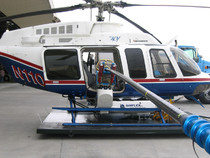AINonline: Simplex Aerospace Cleans Up with New Helicopter Power Wash System
02/13/2012 Dallas, TX Heli-Expo 2012
AINonline.com
By: Chad Trautvetter
Simplex Aerospace recently received FAA STC approval for its third-generation, high-pressure Aerial Cleaning System (ACS), used in the cleaning of power-line insulators and windmill blades. ACS, which consists of a belly water tank and a side-mounted nozzle boom, is certified for use on Eurocopter AS350 and AS355 helicopters. (A 120-gallon, second-generation power-wash system is also certified for the Bell 407.)
Routine cleaning of power-line insulators and wind-turbine blades significantly enhances power transmission and generation, noted Simplex. “This new system will allow operators to accomplish the power-line and wind-turbine-blade cleaning mission with enhanced productivity and safety,” said Simplex president and CEO Mark Zimmerman. “This product represents several years of refinement resulting in the most efficient and effective solution for utility cleaning.”
While the system was intended just for cleaning, the launch customer of the AS350/355 system, Canadian Helicopters, is using it for de-icing of wind-turbine blades in Canada with its AS350B3. Because of environmental regulations, Canadian Helicopters cannot use glycol to de-ice the blades, so it simply uses hot water to melt away the ice, which can be as thick as eight inches, Simplex vice president of sales and marketing Larry Lichtenberger told AIN here at Heli-Expo.
The power-wash system for the AS350/355 uses a 180-gallon water tank, which significantly increases operating times between refills. This capacity allows operators to clean at least all three blades of a wind turbine or about 100 power line insulators, Lichtenberger said, though he added that it really depends on how dirty the blades or insulators are.
According to Simplex, the system’s boom nozzle extends past the rotor tips, providing extended washing distance, permitting operators to clean hard-to-reach insulator strings. The power-assisted operator control reduces operator fatigue, facilitating safer and longer operating days, the company said. The boom’s radius of action is also limited to avoid contact with the main- and tail-rotor blades.
High-rise Firefighting System Being Developed
Simplex has also adapted its power-wash system into another new product–an aerial firefighting system for high-rise buildings. Ground-based firefighting equipment can reach only the first 11 floors of a high-rise, leaving an obvious gap in the ability to contain fires in higher up floors, Lichtenberger said.
Called the Hydro Foam Cannon, the device actually merges the company’s power-wash boom with its high-capacity aerial firefighting water tanks and incorporates a patented compressed air/foam technology to create enough pressure to effectively fight building fires.
The patented pressure system, developed by partner Heliap Aviation Products, is key to the water cannon. While it weights only 20 pounds, the chemical-reaction pressure system allows delivery of 1,000 cubic feet per minute of a water/foam mixture (0.4 percent foam) at 500 psi, with a resultant 120-foot wash range. Simplex president and CEO Mark Zimmerman told AIN that a comparable mechanical pressure system would weigh nearly 2,000 pounds, much too heavy for aerial applications.
Like the power-wash system, the water cannon’s power-assist boom extends past the tips of the main-rotor blades, allowing the water/foam mixture to maintain its integrity to fight fires. Zimmerman said the Hydro Foam Cannon can also be used to apply dry foam to the outside of the building to prevent the fire from spreading upwards.
The tank capacity of the water cannon system will vary on the helicopter, ranging from a 400-gallon tank on a medium Bell to a 2,000-gallon tank on an Erickson Air-Crane. At a flow rate of 150 gallons per minute, the 600-gallon tank on a Eurocopter EC225 would provide four minutes of high-rise firefighting capability.
Simplex is currently ground testing the Hydro Foam Cannon and plans to fly it later this year on an as-yet undetermined helicopter platform. STC approval is expected later next year, with deliveries immediately following.









